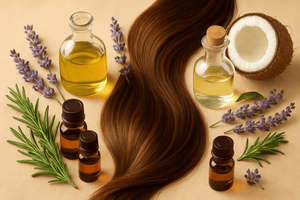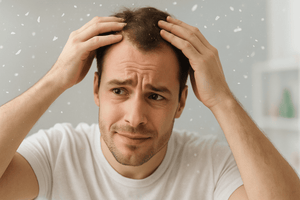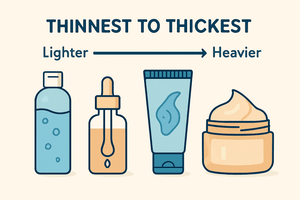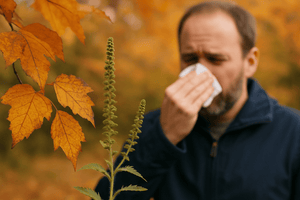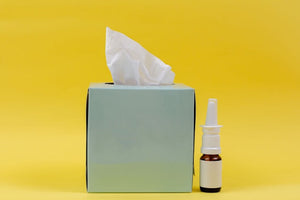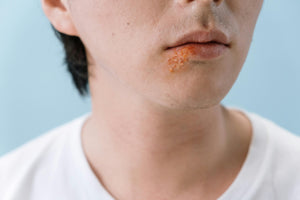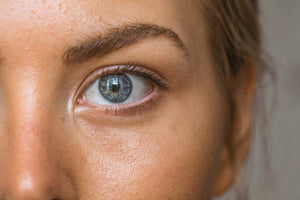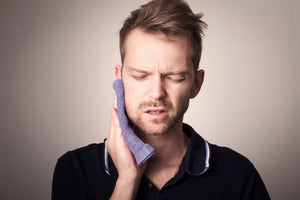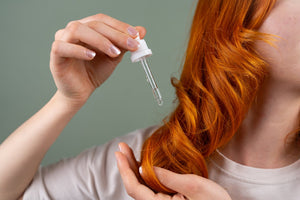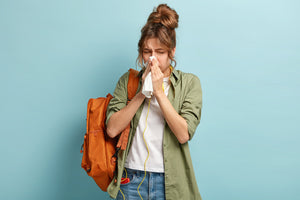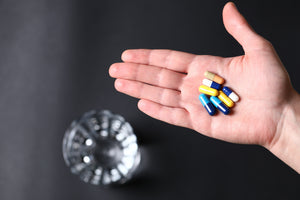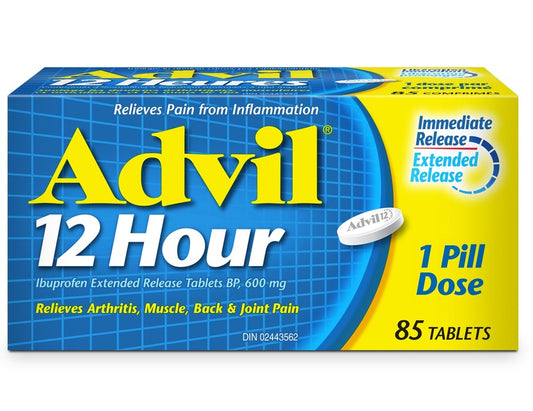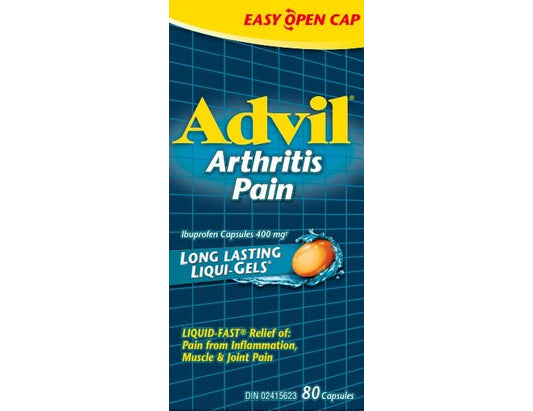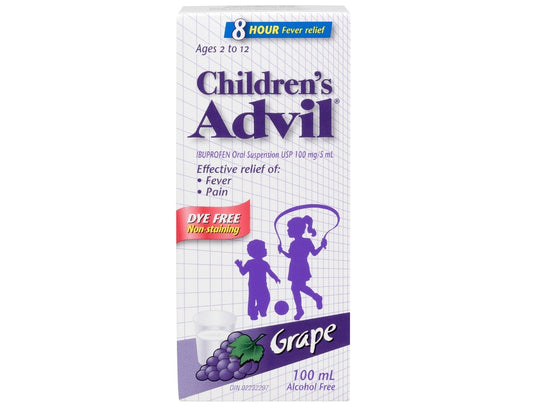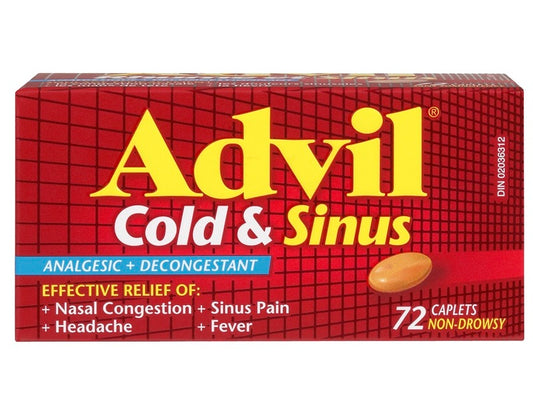Few things are as frustrating as an itchy, flaky scalp. You scratch, you check your shoulders for tell-tale white specks, and you wonder: is it dandruff, or is it just a dry scalp? This common confusion often leads to ineffective treatments, leaving you feeling helpless. Understanding the precise difference between dandruff and dry scalp is the first crucial step towards finding true relief and restoring your scalp's health.
In this comprehensive guide, we'll demystify these two distinct, yet often mistaken, scalp conditions. We'll explore their unique symptoms and underlying causes, provide practical tips for self-diagnosis, and outline effective treatment strategies, from over-the-counter solutions to nourishing home remedies. You'll learn how to accurately distinguish between dandruff vs dry scalp and gain the knowledge to confidently choose the right path to a healthier, happier scalp.
Dandruff Explained: What It Is and Why It Happens
Dandruff isn't just dry skin. It's a common, chronic scalp condition characterized by a flaking scalp. While often harmless, it can be itchy and embarrassing. The key to understanding dandruff lies in its primary cause: a naturally occurring yeast-like fungus called Malassezia globosa.
What is Dandruff?
Dandruff is primarily caused by an overgrowth of Malassezia globosa, which thrives in oily environments. This fungus breaks down sebum (the natural oils on your scalp), producing oleic acid. For about half of the population, this acid irritates the scalp, leading to an accelerated shedding of skin cells. This rapid cell turnover results in the visible flakes associated with dandruff. It's often linked to seborrheic dermatitis, a more severe form of the condition that can affect other oily areas of the body.
Common Symptoms of Dandruff
Knowing the specific symptoms of dandruff can help you determine if it's truly dandruff or dry scalp. Here's what to look for:
- Flake Appearance: Dandruff flakes are typically yellowish or greyish, and often appear larger and oilier than those from a dry scalp. They tend to stick to hair strands and the scalp.
- Scalp Sensation: The scalp beneath the flakes is often red, inflamed, and can be quite itchy. This itchiness is usually more persistent and intense than with a dry scalp.
- Scalp Condition: The scalp itself might appear oily or greasy, as the Malassezia fungus thrives in such conditions.

Causes of Dandruff
While Malassezia globosa is the main culprit, several factors can contribute to its overgrowth and the development of dandruff:
- Oily Skin: Individuals with naturally oily skin (seborrheic skin) are more prone to dandruff, as the fungus feeds on skin oils.
- Infrequent Shampooing: Not washing your hair regularly can lead to a buildup of oils and dead skin cells, providing a fertile ground for Malassezia to proliferate.
- Certain Medical Conditions: Conditions like Parkinson's disease, weakened immune systems, and even heart attacks or strokes can increase the risk of developing dandruff or more severe seborrheic dermatitis.
- Stress: High stress levels can exacerbate existing scalp conditions, including dandruff.
- Diet: While not a direct cause, some theories suggest a diet high in processed foods or certain fats might influence scalp health.
Types of Dandruff
Dandruff can manifest in various forms, from mild flaking to more severe cases. While most common dandruff is a mild form of seborrheic dermatitis, understanding the nuances can be helpful. Persistent, severe flaking, redness, and inflammation might indicate a more pronounced case of seborrheic dermatitis, which could also affect other areas like eyebrows, nose, and ears.
Dry Scalp Demystified: The Truth About Hydration
A dry scalp is a condition caused by a lack of moisture in the skin of your scalp. Think of it like dry skin on any other part of your body – your hands, face, or legs. When your scalp doesn't have enough natural oils, or when external factors strip away its moisture, it becomes dry.
What is Dry Scalp?
Unlike dandruff, a dry scalp is simply a lack of moisture. Your scalp's skin barrier is compromised, allowing moisture to escape, leading to dryness and sometimes irritation. It's a common issue, especially in certain climates or with particular hair care habits.
Common Symptoms of Dry Scalp
The symptoms of a dry scalp share some similarities with dandruff, which is why the difference between dandruff and dry scalp is often confusing. However, there are key distinctions:
- Flake Appearance: Flakes from a dry scalp are typically small, white, and powdery. They tend to shed easily and may be visible on your clothing, similar to general dry skin flakes.
- Scalp Sensation: Your scalp might feel tight, itchy, and sometimes a little irritated. The itchiness is usually less intense than with dandruff.
- Other Dryness: You might notice dryness on other parts of your body, such as your face, hands, or legs, indicating a general tendency towards dry skin.

Causes of Dry Scalp
Numerous factors can contribute to a dry scalp, ranging from environmental conditions to your daily hair care routine:
- Cold and Dry Weather: The lack of humidity in the air, especially during colder months, can strip moisture from your scalp.
- Harsh Shampoos and Hair Products: Shampoos containing strong sulfates or other harsh chemicals can strip the scalp of its natural oils, leading to dryness.
- Frequent Washing: Washing your hair too often can remove natural oils, leaving your scalp vulnerable to dryness.
- Dehydration: Not drinking enough water can impact your skin's overall hydration, including your scalp.
- Certain Skin Conditions: Underlying skin conditions like eczema or psoriasis can cause localized dry patches and flaking on the scalp.
- Hot Water: Washing your hair with very hot water can strip away natural oils and contribute to dryness.
Dandruff vs. Dry Scalp: Key Differences at a Glance
Distinguishing between dandruff vs dry scalp is crucial for effective treatment. While both conditions can cause an itchy, flaky scalp, their underlying causes and the appearance of their flakes differ significantly.

Here's a quick comparison to help you tell them apart:
Dandruff (Seborrheic Dermatitis):
- Flake Appearance: Yellowish, oily, and typically larger flakes. They often stick to hair and scalp.
- Scalp Sensation: Scalp is often red, inflamed, and intensely itchy.
- Underlying Cause: Overgrowth of the Malassezia globosa fungus, thriving in oily environments.
- Scalp Condition: Scalp often appears greasy or oily.
- Affected Areas: Primarily the scalp, but can also affect other oily areas like eyebrows, nose, and ears in more severe cases of seborrheic dermatitis.
Dry Scalp:
- Flake Appearance: Small, white, and dry flakes. They tend to shed easily, resembling general dry skin.
- Scalp Sensation: Scalp feels tight and itchy, but usually less intensely inflamed or red.
- Underlying Cause: Lack of moisture in the scalp's skin, similar to dry skin on other body parts.
- Scalp Condition: Scalp appears dry, sometimes tight.
- Affected Areas: Often accompanied by dryness on other parts of the body (e.g., dry hands, elbows).
This distinction is vital because the treatment approaches for each condition are different. Using a dandruff shampoo for a dry scalp, for instance, might exacerbate the dryness.
How to Accurately Self-Diagnose
While a definitive diagnosis should always come from a healthcare professional, you can perform some simple observations at home to get a clearer idea of whether you're dealing with dandruff or dry scalp.
-
Examine the Flakes:
- Size and Color: Are the flakes small, white, and powdery (dry scalp)? Or are they larger, yellowish, and perhaps a bit oily (dandruff)?
- Adherence: Do the flakes easily fall off your scalp and hair (dry scalp)? Or do they tend to cling to your hair and scalp (dandruff)?
-
Feel Your Scalp:
- Oiliness: Does your scalp feel tight and dry, or does it seem oily and perhaps even a bit greasy to the touch? An oily scalp with flakes often points to dandruff.
- Itchiness: How intense is the itch? Is it mild and intermittent, or persistent and sometimes burning? More intense, inflammatory itchiness is often associated with dandruff.
-
Check Other Skin Areas:
- Do you have dry skin on other parts of your body, such as your face, hands, or legs? If so, your flaky scalp might simply be part of a general dry skin tendency, indicating a dry scalp.
-
Consider Recent Changes:
- Have you recently changed your shampoo or hair products?
- Has the weather become significantly colder or drier?
- These environmental and product-related factors often contribute to a dry scalp.
Remember, self-diagnosis is a starting point. If your symptoms are severe, persistent, or accompanied by other concerns, it's always best to consult a pharmacist or doctor.
Effective Treatment Strategies for Dandruff
If your self-diagnosis points to dandruff, the good news is that many effective over-the-counter (OTC) solutions are available in Canada. The goal of dandruff treatment is to control the overgrowth of the Malassezia fungus and reduce scalp inflammation.
Over-the-Counter (OTC) Medicated Shampoos
Medicated shampoos are the cornerstone of dandruff treatment. They contain active ingredients designed to combat the fungal overgrowth and soothe the scalp. Look for these key ingredients:
- Zinc Pyrithione: An antifungal and antibacterial agent that helps control Malassezia growth. Found in popular brands like Head & Shoulders.
- Selenium Sulfide: Another effective antifungal that also slows down the rate of skin cell turnover. Available in products like Selsun Blue.
- Ketoconazole: A broad-spectrum antifungal that is highly effective against Malassezia. Often available in stronger OTC formulations or by prescription.
- Salicylic Acid: A keratolytic agent that helps shed dead skin cells, reducing flakiness. It doesn't treat the underlying fungal cause but can help manage symptoms.
- Coal Tar: Slows down skin cell growth and reduces inflammation. It can be effective but may have a strong odour and can stain light hair.

Key Active Ingredients for Dandruff and Dry Scalp Treatments
You can find a variety of these solutions at Symington Pharmacy. Shop Medicated Shampoos for Dandruff Relief

How to Use Medicated Shampoos Properly
Effective use of medicated shampoos is crucial for successful dandruff treatment:
- Application: Wet your hair thoroughly, then apply a generous amount of medicated shampoo, focusing on massaging it into your scalp. Ensure complete coverage.
- Leave-on Time: Allow the shampoo to sit on your scalp for 5-10 minutes (or as directed on the product label) to allow the active ingredients to work.
- Frequency: For initial treatment, use medicated shampoo daily or every other day until symptoms improve. Once controlled, you can reduce the frequency to 2-3 times a week, alternating with a regular shampoo.
- Rotate Shampoos: If one medicated shampoo seems to lose effectiveness over time, try rotating between two different active ingredients to keep the fungus from adapting.
Lifestyle Adjustments for Dandruff
Beyond medicated shampoos, certain lifestyle adjustments can help manage dandruff:
- Regular Washing: Ensure you wash your hair regularly to prevent oil and dead skin cell buildup, which feeds Malassezia.
- Avoid Certain Hair Products: Heavy, oily hair products can exacerbate dandruff by providing more food for the fungus. Opt for lighter, non-comedogenic options.
- Stress Management: Stress can worsen skin conditions. Incorporate stress-reducing activities like yoga, meditation, or regular exercise into your routine.
- Diet's Potential Role: While direct links are still being researched, a balanced diet rich in vitamins and minerals and low in processed sugars might support overall skin health.
Nourishing Solutions for a Dry Scalp
If your flakiness and itchiness stem from a dry scalp, the focus shifts from antifungal agents to hydration and gentle care. The goal is to replenish moisture and strengthen your scalp's natural barrier.
Moisturizing Shampoos and Conditioners
For a dry scalp, choose shampoos and conditioners specifically formulated to provide hydration without stripping natural oils. Look for ingredients that attract and retain moisture:
- Hyaluronic Acid: A powerful humectant that draws moisture from the air into the scalp.
- Glycerin: Another excellent humectant that helps to hydrate the skin.
- Ceramides: Lipids that are naturally found in the skin barrier; they help repair and strengthen the barrier to prevent moisture loss.
- Natural Oils: Ingredients like argan oil, jojoba oil, and tea tree oil (in diluted forms) can provide natural moisture and soothing properties. Tea tree oil, while naturally antifungal, is primarily used here for its moisturizing and anti-inflammatory properties for dry scalp.

Explore a wide range of hydrating hair care products at Symington Pharmacy. Discover Hydrating Hair Care & Scalp Treatments
Scalp Treatments & Oils
Beyond daily shampoo and conditioner, targeted scalp treatments and oils can provide intensive hydration for a dry scalp:
- Leave-in Conditioners: These can offer continuous moisture throughout the day.
- Scalp Serums: Formulated with concentrated hydrating ingredients, serums deliver targeted relief.
- Natural Oil Massages: Gently massaging natural oils (like jojoba, argan, or diluted tea tree oil) into your scalp before shampooing can deeply nourish and moisturize. Apply a small amount, leave for 20-30 minutes, then shampoo thoroughly.
Browse Scalp Treatments & Oils
Adjusting Your Hair Care Routine
Your hair care routine plays a significant role in dry scalp treatment:
- Washing Frequency: Reduce how often you wash your hair. Every 2-3 days, or even less if your hair can tolerate it, can help preserve natural scalp oils.
- Water Temperature: Use lukewarm water instead of hot water, which can strip your scalp of essential moisture.
- Avoid Harsh Chemicals/Sulfates: Choose sulfate-free and paraben-free products to prevent further drying and irritation.
- Gentle Drying: Avoid harsh towel drying or excessive heat from blow dryers. Pat your hair gently and allow it to air dry partially before using a dryer on a cool setting.
Environmental Factors
Be mindful of environmental factors that contribute to dryness:
- Humidifiers: In dry climates or during winter, using a humidifier in your home can add moisture to the air, benefiting both your skin and scalp.
- Protect Your Scalp: When exposed to harsh elements (extreme cold, wind, sun), consider wearing a hat or scarf to protect your scalp.
Can You Have Both? Managing Combined Conditions
It is indeed possible to experience both dandruff and dry scalp at the same time. This can occur when an underlying oily scalp (prone to dandruff) is also subjected to drying factors, or if someone with a generally dry skin type develops a mild form of dandruff.
When both conditions are present, it can be a bit trickier to manage, but not impossible:
- Address the More Severe Symptom First: If one condition is significantly more bothersome, focus on treating that primarily. For example, if the itchiness and inflammation of dandruff are severe, prioritize medicated shampoos.
- Alternating Products: You might need to alternate between a medicated dandruff shampoo and a hydrating shampoo or conditioner. For instance, use an anti-dandruff shampoo two to three times a week, and on other wash days, use a gentle, moisturizing product for dry scalp.
- Targeted Treatments: Consider using a leave-in scalp moisturizer or oil on dry areas after using a medicated shampoo, focusing on the ends of your hair if needed. Avoid applying heavy oils to the entire scalp if dandruff is still active, as this could worsen fungal growth.
- Gentle Routine: Regardless of which condition is more dominant, a gentle hair care routine is paramount. Avoid harsh scrubbing, very hot water, and excessive heat styling.
Managing combined conditions requires patience and observation to see how your scalp responds to different products and routines.
When to See a Doctor or Pharmacist
While many cases of dandruff or dry scalp can be effectively managed with over-the-counter products and home remedies, there are times when professional medical advice is necessary. It's important to know when to seek help to ensure proper diagnosis and prevent complications.
Consult a Doctor or Pharmacist if you experience:
- Persistent or Severe Symptoms: If your flaking, itching, redness, or irritation doesn't improve after several weeks of using appropriate OTC treatments.
- No Improvement with OTC: If the recommended shampoos or hydrating treatments provide no relief.
- Redness, Swelling, or Pain: If your scalp becomes significantly red, swollen, tender, or painful, these could be signs of a more severe condition or infection.
- Hair Loss: While usually not directly caused by common dandruff or dry scalp, excessive scratching or severe inflammation can sometimes lead to temporary hair thinning or loss. This warrants medical attention.
- Signs of Infection: Pus-filled sores, crusted areas, or increasing pain on your scalp could indicate a bacterial or fungal infection that requires prescription treatment.
- Uncertainty: If you're still unsure whether it's dandruff vs dry scalp after trying to self-diagnose, a healthcare professional can provide a precise assessment.
Pharmacists in Canada are highly knowledgeable and can offer valuable advice on distinguishing between these conditions and recommending appropriate products. They can also guide you on proper product usage and when to escalate to a doctor.

For personalized advice and product recommendations tailored to your specific scalp needs, don't hesitate to reach out to the healthcare professionals at Symington Pharmacy. Need Personalized Advice? Our Pharmacists Are Here to Help.
Prevention Tips for a Healthy Scalp
Maintaining a healthy scalp isn't just about treating problems; it's about prevention. By adopting consistent and gentle hair care practices, you can significantly reduce the likelihood of experiencing dandruff or dry scalp.
Here are actionable steps for a healthy scalp:
-
Consistent, Gentle Hair Care:
- Wash Regularly but Not Excessively: Find a washing frequency that suits your scalp type. For most, every 2-3 days is ideal to remove buildup without stripping natural oils.
- Use Lukewarm Water: Hot water can strip moisture. Opt for lukewarm water when washing your hair.
- Choose Mild Products: Look for shampoos and conditioners that are free from harsh sulfates, parabens, and strong fragrances, especially if you have a sensitive scalp.
- Rinse Thoroughly: Ensure all shampoo and conditioner is rinsed out to prevent product buildup that can irritate the scalp.
-
Proper Hydration (Internal and External):
- Drink Enough Water: Staying well-hydrated internally benefits all your skin, including your scalp.
- Consider a Humidifier: In dry indoor environments, a humidifier can add moisture to the air, preventing scalp dryness.
-
Balanced Diet:
- While not a direct cure, a diet rich in essential fatty acids (like Omega-3s found in fish, flaxseed, and walnuts), vitamins (especially B vitamins and zinc), and antioxidants can support overall skin and hair health.
-
Stress Reduction:
- High stress levels can exacerbate many skin conditions, including dandruff. Practice stress-reducing techniques like meditation, yoga, or spending time in nature.
-
Hygiene of Hair Tools:
- Regularly clean your brushes, combs, and any other hair tools to remove product buildup, dead skin cells, and potential microbial contaminants.
By incorporating these simple yet effective prevention tips into your routine, you can foster a healthier scalp environment and keep those pesky flakes at bay, whether it's dry scalp vs dandruff.
Key Takeaways
Understanding the difference between dandruff and dry scalp is the first step towards achieving a healthy, comfortable scalp.
- Dandruff is primarily caused by an overgrowth of Malassezia fungus on an oily scalp, resulting in yellowish, oily, and often larger flakes with significant itch and inflammation.
- Dry Scalp is due to a lack of moisture, leading to small, white, dry flakes and a tight, itchy sensation, often accompanied by dryness elsewhere on the body.
- Self-diagnosis involves examining flake appearance, scalp sensation, and checking for general body dryness.
- Dandruff treatment typically involves medicated shampoos with active ingredients like Zinc Pyrithione, Selenium Sulfide, or Ketoconazole.
- Dry scalp treatment focuses on hydration using moisturizing shampoos, conditioners, and scalp oils with ingredients like hyaluronic acid, glycerin, and natural oils.
- Both conditions benefit from gentle hair care routines, proper hydration, and stress management.
- Seek professional advice from a pharmacist or doctor if symptoms are severe, persistent, accompanied by pain, redness, or hair loss, or if you're unsure about your diagnosis.
A healthy scalp is within reach with the right knowledge and approach.
Find Your Scalp Solution: Explore Our Comprehensive Range of Dandruff & Dry Scalp Treatments at Symington Pharmacy.
We understand the challenges of managing scalp conditions. At Symington Pharmacy, we offer a wide selection of effective products for both dandruff and dry scalp, along with the expertise of our knowledgeable pharmacists ready to provide personalized advice.


